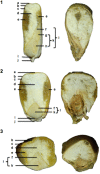Aspergillus flavus infection induces transcriptional and physical changes in developing maize kernels
- PMID: 25132833
- PMCID: PMC4117183
- DOI: 10.3389/fmicb.2014.00384
Aspergillus flavus infection induces transcriptional and physical changes in developing maize kernels
Abstract
Maize kernels are susceptible to infection by the opportunistic pathogen Aspergillus flavus. Infection results in reduction of grain quality and contamination of kernels with the highly carcinogenic mycotoxin, aflatoxin. To understanding host response to infection by the fungus, transcription of approximately 9000 maize genes were monitored during the host-pathogen interaction with a custom designed Affymetrix GeneChip® DNA array. More than 4000 maize genes were found differentially expressed at a FDR of 0.05. This included the up regulation of defense related genes and signaling pathways. Transcriptional changes also were observed in primary metabolism genes. Starch biosynthetic genes were down regulated during infection, while genes encoding maize hydrolytic enzymes, presumably involved in the degradation of host reserves, were up regulated. These data indicate that infection of the maize kernel by A. flavus induced metabolic changes in the kernel, including the production of a defense response, as well as a disruption in kernel development.
Keywords: Aspergillus flavus; aflatoxins; genetic; maize; pathogenesis; transcription.
Figures



References
-
- Benjamini Y., Hochberg Y. (1995). Controlling the false discovery rate: a practical and powerful approach to multiple testing. J. R. Stat. Soc. Series B. 57, 289–300
-
- Black M. J., Bewley J. D., Halmer P. (2006). The Encyclopedia of Seeds: Science, Technology and Uses Wallingford: CABI
LinkOut - more resources
Full Text Sources
Other Literature Sources
Molecular Biology Databases

